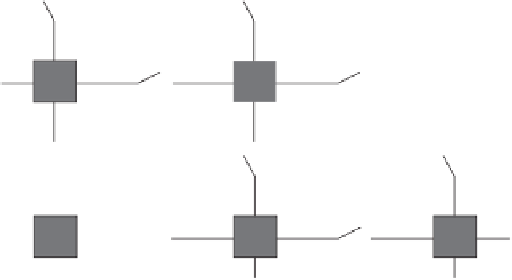Information Technology Reference
In-Depth Information
7.4. SPIN-WAVE RECONFIGURABLE MESH
A nanoscale spin-wave reconfigurable mesh of size N
2
consists of an N
N array
of processors connected to a reconfigurable spin-wave bus grid, where each
processor has a locally controllable bus switch [12], as shown in Figure 7.5.
In the proposed spin-wave reconfigurable mesh architecture with spin-wave
buses, a set of column spin-wave buses on the bottom and a set of row spin-wave
buses on the top are connected via the spin-wave switches. Each switch is placed at
the grid point of the mesh, as shown in Figure 7.6. Basically, the nanoscale spin-
weave reconfigurable mesh is similar to the standard reconfigurable mesh, except
for the spin-wave buses and switches.
It is worth noting that, similar to the standard reconfigurable mesh, the
nanoscale reconfigurable mesh of size N occupies N
N area, under the assump-
tion that processors, switches, and the link between adjacent switches occupy unit
area. However, the main difference in terms of area here is that the unit of area is
at nanoscale level as opposed to the standard reconfigurable meshes that are at
microscale level of integration.
Each of the spin-based devices serves as a one-bit input/output port. One spin-
wave packet excited by one port can be superposed with many packets generated
by the nearby ports. The length of interaction among the spin-based devices is
limited by the spin-wave attenuation caused mainly by the scattering on phonons.
The length of interaction is defined by the material properties of the ferromagnetic
film, film size, and the operation temperature. According to our experimental data
it can be as high as tens of microns.
i
1
, j
1
+
+
i, j
+
1
i
−
1
, j
+
1
“On”
Spin wave switch
i
−
1
, j
i, j
i
+
1
, j
“Off”
100 nm
Spin-based device
100 nm
i
+
1
, j
−
1
i, j
−
1
i
−
1
, j
−
1
Spin wave bus
Figure
7.5.
Reconfigurable mesh architecture.























Search WWH ::

Custom Search